A closer look at the nitty-gritty of some of the alternatives the Guide offers, shows that it still doesn’t address constrained situations common in Portland.
The draft of the City of Portland’s newly updated Pedestrian Design Guide (PDG) has been available to the public for a few weeks now and the Portland Bureau of Transportation (PBOT) is actively soliciting public comments which are due by October 31th. The new draft Guide updates the original 1998 document, and one of its tasks was to recognize the constraints of existing conditions and provide “flexibility and context-sensitive advice for how to approach more challenging and/or ROW-constricted situations” for the city staff who use it. The original 1998 Guide, which was ahead of its time, assumed ideal right-of-way conditions which just do not exist in large areas of Portland.
But a closer look at the nitty-gritty of some of the alternatives the Guide offers—and it is a huge improvement over the 1998 Guide—shows that it still doesn’t address constrained situations common in Portland.
Advertisement
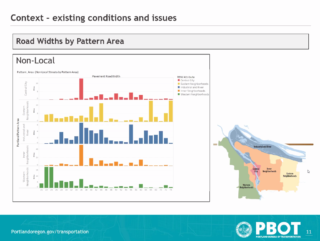
The table of roadway widths by pattern area (right) released by the ongoing PBOT Streets 2035 project shows that non-local roads west of the Willamette are mostly 22 to 24 feet wide. East Portland, which has a variety of streets widths, including most of Portland’s excessively wide streets, also has many 22-24 ROW-constrained “non local” streets. (Streets 2035 didn’t define “non local,” but I assume it means anything PBOT did not reduce to 20 mph under their interpretation of city ordinance 188774, including collector streets.)
The problem is that, at 22 to 24 feet, many of these streets are too narrow to qualify for the alternative treatments the draft PDG offers, or their posted speeds are too high.
The PDG section on “Alternative Pedestrian Walkways” offers a table of treatments (below, Table B-6) followed by pages of descriptions of their appropriate use and minimum requirements. SW Broadway Dr, Patton Rd, Dosch Rd, Humphrey, Taylors Ferry, and so on through just about every collector in Southwest Portland, don’t meet the requirements of any of the treatments in Table B-6.
Portland attorney, safety advocate, and BikePortland contributor Scott Kocher (he’s also a financial supporter of BikePortland) agreed that “either the streets don’t qualify or a lot more width is needed,” and he added that the table “potentially gives folks another reason to say ‘no’” to frontage improvements.
With the PDG decision-making trees and alternatives, it is fair to ask what happens when the “Alternative Pedestrian Walkways” node returns negative—your street does not qualify for any alternative treatment. Then what? The existing condition is that these streets are posted 25 mph, people drive a lot faster than that, there are no bike facilities, and pedestrians walk in the road. Currently, the answer to “then what?” is to maintain that unsafe status quo. The PDG does not address this, but, to be fair, maybe it is not a PDG issue, maybe it is a Streets 2035 issue.
An obvious solution is to lower the posted speed of the street to 20 mph, and to install speed bumps to enforce it. Or even just prohibiting on-street parking and cleaning up what shoulders there are. Without any options for failing to meet the Table B-6 qualifications, Kocher says it “ignores the reality of what is happening in Southwest and East Portland everyday,” and offers a “clear path forward to doing nothing.”

— Lisa Caballero, lisacaballero853@gmail.com
— Get our headlines delivered to your inbox.
— Support this independent community media outlet with a one-time contribution or monthly subscription.




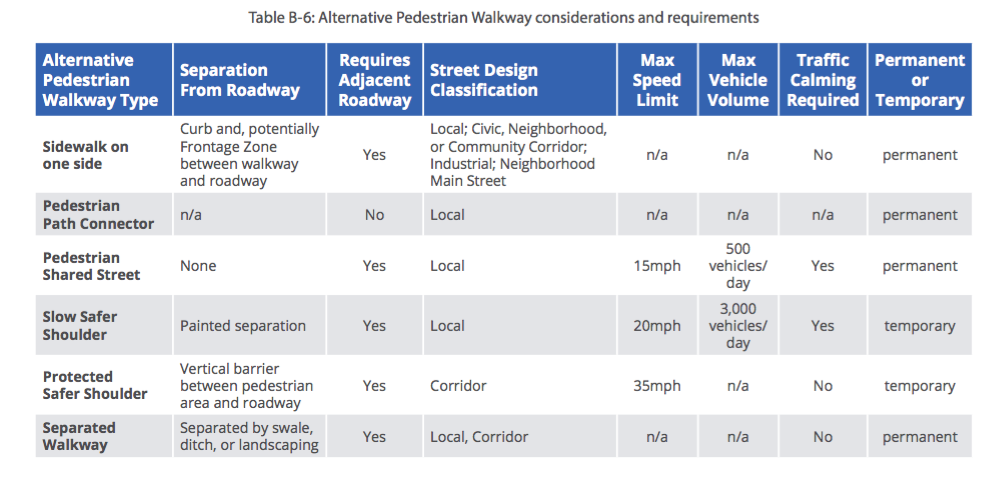

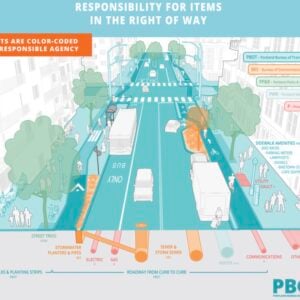
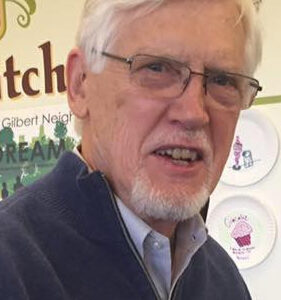
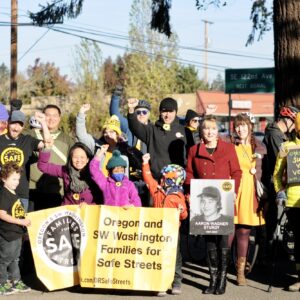
Thanks for reading.
BikePortland has served this community with independent community journalism since 2005. We rely on subscriptions from readers like you to survive. Your financial support is vital in keeping this valuable resource alive and well.
Please subscribe today to strengthen and expand our work.
Thanks for laying this all out Lisa! I hope people will read pages 44-46 and comment on how to expand these options so they can provide safe speeds and walking space, especially for SW and East Portland streets without sidewalks. With a good toolkit we can (mostly) fix some of the worst walking streets for low cost.
And, if PBOT won’t continue to roll out lower speeds to the full extent of the authority the legislature gave us (e.g. 10 MPH where width for vehicle travel is 18’ or less) we need to solve that. Grr!
This is great analysis Lisa. Thank you so much for taking the time to do this in time for people to send public comments before the end of the month!
“A clear path forward to doing nothing” sounds like the perfect slogan for a transportation department that is far more interested in creating plans to address safety and climate concerns than actually implementing them.
WOW! First update since 1998!! I just wish to add a loud shout out to the ‘PDOT’ staff [and consultants] that worked on the 1998 design guide as it was so ahead of its time for most US cities (so ahead it was ‘behind’)…I used it as a pre-internet hard copy resource in my pedestrian advocacy efforts in Honolulu (before Vancouver recruited me away).
So ‘Mahalo nui loa’ to Ellen Vanderslice, Doug Klotz (I loved his pen illustrations), and I assume many more!
https://bikeportland.org/2021/02/09/a-push-for-bike-lanes-and-a-more-people-focused-hawthorne-26-years-ago-325819
I was surprised when I came across Doug Klotz’s drawings, they are wonderful. I’m sorry the world has moved away from hand-drawn illustrations.
“SW Broadway Dr, Patton Rd, Dosch Rd, Humphrey, Taylors Ferry, and so on through just about every collector in Southwest Portland, don’t meet the requirements of any of the treatments in Table B-6.”
The lack of safety of those streets is a huge impediment in SW to walking or biking. And most of SW isn’t a grid–it’s a series of pockets of small neighborhood streets that you can’t leave without getting onto one of those collectors. So many residents can’t go more than a few blocks (meaning can’t walk or ride to a grocery store, school, park or even a bus stop) without having to use an unsafe collector.
PBOT’s motto: “If it’s not the inner Eastside, we don’t care!”
PBOT no longer seems to care about the inner Eastside; I’d amend your statement to:
PBOT’s motto: “We don’t care!”
At a neighborhood meeting, I once told a traffic engineer that all of PBOT’s flow charts inevitably bounced the ball down to NO on any safety improvements for these streets… not enough sight distance for a crosswalk, too many cars for this solution, too narrow for that one. I stated they were either gonna have to come up with some creative ideas, or loosen their sphincters a whole bunch and just deal with on-ground reality instead of engineer’s handbook perfection. They seemed to agree. And I took another staffer for a tour of one of these streets and I think I scared them (lots of PBOT dump trucks going by at about 40mph helped). We discussed a number of great solutions – for the record, this person absolutely saw the problem and made committments to fix as much as possible – but I pressed the issue a bit and asked what’s left if none of your proposals get past some rule or policy? “We’re back to walking in the street, and the only option left is lowering the speed limit, and speed bumps and tables, right?” I’m not going to put words in their mouth, so i won’t say their answer was ‘yes’ but they did acknowledge the logic.
Well, we know how enthused some parts of PBOT have been to do either of those things. And they’re happy as clams when removing lanes on Powell and slowing traffic that way, but deeply insulted when asked to slow traffic on narrower streets in any way at all.
Then there’s the Development side, which is proposing to ask developers to throw a few more coins in the kitty rather than fixing their frontage issues. Which is worse than status quo, as all the peds/cyclists now get to deal with the same situation with MORE traffic.
There are excellent staffers at PBOT who GET IT. My opinion is that they are outgunned by those who don’t… or who have a vested reason to NOT get it. Pedestrians and cyclists need to flood that comment page linked above to give some ammo to those who are in the Got It camp.
It is completely untenable to continue development in areas like these and provide no transit option. It is completely untenable to continue development in areas like these and provide no ped/bike improvements to safely REACH those options. And as far as equity goes, if the city is right, a good 30% of new residents in these areas will live in missing-middle or affordable housing, meaning the city has placed these people in the same sorts of safety disequities that PBOT is trying to unwind elsewhere… LOTS cheaper to prevent that than fix post facto. Making new charts explaining why they can do nothing isn’t gonna help.
A new-agey boss once told me “There is no NO; there is only the journey to YES.” Time to start the journey PBOT!
This was a great analysis. I lived (and bike commuted) more than a decade in outer SW & it’s worth remembering that with no grid there are few side streets to route around collectors (for any mode of travel). You travel on the 2-lane 35mph+ collector with no shoulder or sidewalk, or you stay home. Something has to change, either we will choose to change it with some intention, or it will be changed for us by default. Spend 30 minutes at Taylor’s Ferry & Terwilliger at rush hour & you’ll get a sense for what the default will be.
I’ve been thinking about this line all night:
That right there is Portland’s motto for the 21st century.
East Portland has an equal but opposite problem compared to SW – those super wide arterial stroads all have too-narrow sidewalks. Theoretically lanes and parking can be taken away to expand the sidewalk widths, except that cost would be astronomical since the sewers and curbs would also have to be moved, and so nothing is getting done except for small piecemeal projects.
Such design guides from PBOT and BPS remind me of body-shaming guidelines from the feds to combat nationwide obesity rates – lots of advice, lots of shaming, but little in actual proven methods for improvement – and poor people seem to just get fatter and the shaming and bullying just seems to get worse. It’s much the same about inner Portland versus the more recently annexed parts of the city – lots of shaming but no actual improvement.
I assume SW Trails…Don Baak’s group, is weighing in on this issue for SW. I grew up in Multnomah, and somehow we managed to get around on foot and on bikes in the good old 50’s.
There were “learned networks” of unpaved, potholed streets with low speed, low volume traffic, so one could just walk or bike down the middle. Not much has changed. The street I grew up on is still unpaved. LID’s are hopelessly expensive because of the storm water issue and pavement just encourages speeds and volume.
My late father had heart surgery in ’65, and along with blood thinner was told by his doc to walk three miles every day. He walked to Lewis & Clark College…by a variety of connected back streets…regularly for years. His biggest problem was loose dogs, so he carried a stick. Which brings me back to SW Trails. They have done a lot of thinking, mapping, and low cost construction in order to enhance and make known the existing non-motorized network in SW. PBOT knows of their work and sometime assists them. Liability is a big issue if something…steps or a path…is not “up to code.” So its complicated, but not undoable. Throwing away the book and innovating with folks on the ground may be the best path forward in SW.
Thanks, Lisa, for continuing to highlight the opportunity behind the PDG update. Please note that the PDG is our one chance to get at many of the challenges you raise. And this is occurring through an administrative rule change – there will be no City Council review of the PDG as far as I can tell.
Also, at this time it is unclear what public process – if any – will be afforded for the Streets 2035 initiative. Most of the Streets 2035 action to date has been occurring behind closed doors by bureau staff, with only briefings for various advisory committees.
My suggestion to folks commenting on the PDG is to ask for more time and more public process. And to use this as a platform to talk about the lack of public engagement on the Streets 2035 process.
-Ted
Thanks for digging into policy at a critical policy juncture. Many of the lesser improved transportation right of way has narrow road as-paved widths. But they do have wider right of way.
Because the City threw up their hands on drainage, which is usually provided by curbs and sidewalks, we have ditches in the right of way for the storm water concentrated by the water-impermeable roadway.
There has been research in PBOT on permeable paving over drainage ditches. The problem is that the current permeable pavements are destroyed by the weight of a car, truck, or delivery vehicle, so you are back to curbs to protect them. Those permeable surfaces support bicycles and walkers easily.
Because the ditches are BES, sometimes there is BES funding which solves bike and ped access in collaboration with PBOT. So I would include Commissioner Mapps in discussions.
PBOT uses an improvement by foot cost for roadway types. I believe the “curb” upgrade cost is burdened by unnecessary piping and storm water costs. It might be worth a tactical revamp of the PDOT cost book with some demonstration projects.
To the table, many streets people walk and bicycle would fall into the slow safer shoulder, but PBOT is unwilling to widen them to that even on one side because it would impinge on BES drainage. What pedestrians and cyclists want is protected safer shoulder and curb with sidewalk. Perhaps there is a new classification in the table required?
As an aside, I have seen in China a modular concrete drainage ditch, curb, and sidewalk. It was used as a sanitary sewer there, but it could be used as a storm sewer here.
NW Cornell is blocked to car travel and the world has not ended. Perhaps the problem of errant car traffic could be remediated in some places by installing retractable bollards.
Some will no doubt point out that traffic will increase on adjoining streets which could be true. However there’s also reason to believe that when facilities are reduced some car trips just go– Away.